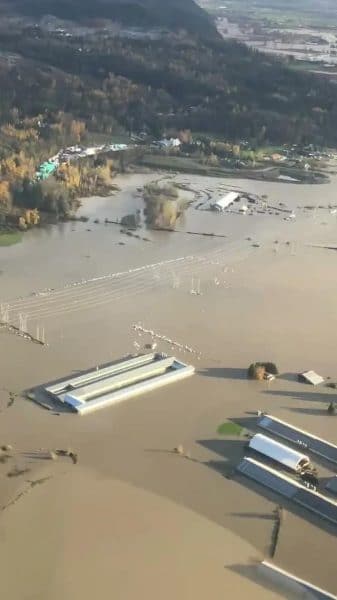The BC Dairy Association (BC Dairy) has completed a preliminary assessment of the impacts of flooding on cattle and dairy farms in the Abbotsford and Yarrow area.

At this time, BC Dairy’s preliminary estimate is that of the approximately 23,000 cattle located in the region prior to the floods, about 500 are deceased as a result of flooding. An estimated 6,000 cattle were evacuated to other farms in the Abbotsford, Chilliwack or Agassiz areas and are being cared for there, while an estimated 16,000 remained on their own farms. It is possible the number of deceased cattle may rise should more flooding occur or more animals need to be euthanized due to health problems caused by the flooding. Sixty-two farms in the Abbotsford and Yarrow areas were under Evacuation Orders at the peak last week.
BC Dairy is working with the province, transport companies, farmers, and volunteers to ensure cattle remaining on impacted farms are housed, fed, and watered. Significant amounts of grain and supplies have been transported to the affected farms.
“While just one cow perishing in a natural disaster is disheartening, it is a credit to the tireless work of farmers, their families and volunteers that so many cattle were saved and so few lost,” says Holger Schwichtenberg, chair of the BC Dairy Association and a dairy farmer in Agassiz. Schwichtenberg and his family operate one of the dozens of dairy farms which have taken in cattle from the flooded farms, ensuring they are housed, fed, and milked until able to return to their home farms.
Milk pickup
Further, approximately 80 percent of milk being produced on BC farms is now being picked up for processing, which is sufficient to meet the province’s immediate demand for fluid milk. The BC Milk Marketing Board had to suspend milk pickup at farms in a number of regions of BC last Tuesday due to the flooding and road closures. That created some difficulty supplying milk to fluid processing plants in BC.
Milk from the Okanagan and Kootenays is temporarily being shipped for processing in Alberta until the situation on Highway 3 improves and milk can again be transported to the Lower Mainland for processing. Milk from farms in the eastern Fraser Valley is being trucked along highway 7. This adds 4-5 hours to the drive time, but does allow milk to get through. That is, however, straining the transportation fleet so transport companies are not able to pick up all milk produced in the Fraser Valley. That likely won’t improve until highway 1 through Abbotsford re-opens. The farms still flooded in the Sumas prairie represent about 14 percent of the province’s milk volume.
Provided by BC Dairy




